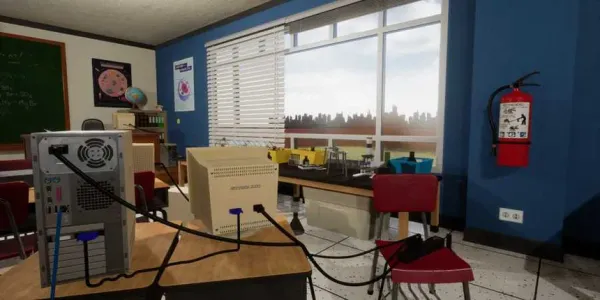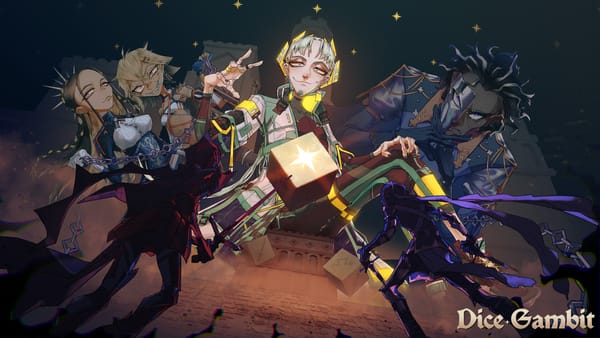Chaos Rings and the chaotic frailty of mobile gaming history - LudoLudo Dissonance

Written by Rinoa Carmichael

Games are a big medium. It’s impossible to know every game, follow every format, genre, region, and so naturally we are all going to fall into blind spots. This is natural and fine in a general sense. However, mobile gaming has often existed in a quick to dismiss space, and when combined with the fleeting nature of the app stores and updates, it’s very easy to lose a lot of interesting titles to time. So, today, just in time for it’s 11th anniversary I’m going to cover one of my favorite forgotten mobile games.
Chaos Rings is a mobile game that was released in 2010 on iOS, later coming to Android, Playstation Mobile, Amazon App Store and the Playstation Vita. Mobile gaming history is by many, often ignored, and generally hard to access now, being delisted on most platforms in 2016. Right now in order to play this game, you need a 32 bit iOS or android device, and to have already bought it, or a vita set up with a Japanese PSN account to buy it. This piece was sparked by the now cancelled PSP, PS3 and PSV store closures, so for once Chaos Rings has cheated death, but for how long?
And it seems like the closest Square got to acknowledging the 10th Anniversary was with this reply to someone calling them out for not mentioning the 10th anniversary.
Before we talk about the game though, I want to spend the time establishing 2010 in the mobile space, as it was an important moment in mobile gaming. With the iPad having come out in April that year and Angry Birds having risen to absurd popularity, mobile gaming was in a moment to prove itself as something “serious.” While many “hardcore” games had already been released for mobile by this point, there was extra light and perhaps extra effort to stand out this year.
A lot of interesting titles were released too, ranging from competent clones (The War Of Eustrath) to major series getting interesting format specific versions (Mirror’s Edge). While I would love to cover a lot of this year in mobile gaming, as this era was a time when mobile was a real source of inspiration and hope for many developers, there is one game in particular that stands out to me: Chaos Rings.

Chaos Rings is not a masterpiece. I’m not here to tell you it’s secretly one of SquareEnix or Mediavision’s best works, nor is it the secret Wild Arms 6 we were all waiting for. But Chaos Rings was important at the time. This was a “real” developer devoting a lot of resources and energy to make not only something new but a new IP for mobile. Many developers, had made mobile spin offs of major games. But this signed a commitment and confidence in the platform. Chaos Rings was not a throwaway old brand, simple port or spin-off. It had talent behind it, a distinct look and sound, and a unique tone to its story and structure that makes it today still feel very unlike much of either companies’ output. If you look at it now it might not seem like much, but at the time we hadn’t really seen much like it made uniquely for mobile by a high profile studio. Many people viewed this game as in some ways legitimizing phone gaming from beyond simple puzzles and time wasters.

So, I’ve talked a lot about it’s place in time, but what IS Chaos Rings? It’s a turn based RPG, where you explore an overworld made up of pre-rendered backgrounds and random encounters much like Square’s previous work on the PS1. The story and gameplay is structured around a battle royale between couples plucked out of their lives to compete for eternal life and youth. Sometimes these pairings are healthy and reflect real connections, sometimes, less so. As you play through with each couple you see different perspectives and possibilities within the story. For a mobile game, Chaos Rings had high production values, but clearly still a limited budget, and so this structure does seem like a choice to make the most of each asset. I’m not going to talk much about the story and the structure beyond that, for a deeper rundown consider reading the first RPG reload on toucharcade.
This coupling concept though is a big influence on the battle system. Every single round of combat you are presented with a simple set of options:

The main mechanic of Chaos Rings’ battle system is actually an elegant way of presenting turn economy and simple positioning to a player. Characters can either act solo or as a pair, combining their stats together for an impactful turn.
But, when acting as a pair, you also count as a single target, meaning while you can cast the powerful single target healing spell on both of you, you also will both take the next hit together. But if you act solo, then you get two weaker turns, and function as separate targets.

By presenting this choice at the start of each round, it encourages players to think about what they want out of a turn. It is all too easy in many similar RPGs to get into an auto-pilot situation and mash that attack button unthinkingly. But here this choice is deliberate each turn. The touch interface itself plays a part in this even. In many RPGs, your cursor will sit on default commands to quickly click though, or even remember the last commands you selected. By not even having a default command it encourages you to make an actual choice each time rather than settle for what was done last turn.

The game early on can be rather hard too! As the level of the random encounters can be chosen the player and the game encourages you to fight monsters stronger than you to acquire new skills quickly. If you play a tier above your current level as the game encourages you to, death can be quick. So using the pair/solo options to finish a combat early can be the difference between life or death, at least in the first third or so in the game, as the difficulty tends to subside as you acquire more abilities.
Continuing the interest in making each turn different, the pair/solo mechanic is matched with a unique elemental system. At first glance it may seem like a simple rock paper scissors, the twist is that by elemental spell, you set your element to one within the triangle. Meaning that once you start engaging with the rock paper scissors elements you also are committing yourself to having abusable weaknesses. Meaning your and enemy weaknesses can constantly shift and so no battle is just a simple “keep casting fire until they are dead” situation.

These combine to keep what is otherwise a relatively simple battle system with fairly easy customization fun and engaging for 7-10 hours playing as a couple might take you. The options for playing foes at higher or lower levels than you also lets you engage as you like with the systems. Maybe you just want to turn your brain off a bit and listen to a great podcast, set encounters to a lower or equal level? Great! You’ll maybe earn a few less new things but you’ll still earn the general EXP and still have a chance at new abilities. Maybe you are sitting down ready to engage, maybe tune them up? Really accelerate your progression as a reward for being willing to engage with the systems. Maybe you are just done with random encounters and confident about your power, well turn off random encounters then.
So we have a game with a unique multi perspective narrative, a battle system that allows you to engage as you do or don’t want, and provides compelling reasons for engaging, making this a fascinating game that plays with some very basic RPG concepts in ways we don’t see many games focus on. This game has always stuck firmly in my mind, and I remember it being one of the default “best mobile games” for years, but now it just seems so gone in a way you don’t see for other bests. We don’t see fans rising out to bring it back, and the only game in the series left to buy for those not interested in setting up a Japanese Playstation Network account for their Vita is the fourth game Chaos Rings III. (which is pretty good! But an entirely different beast to this first game)

It’s very easy to dismiss mobile games. In the genre writing that consists of shallow dives like this, we see certain games and genres being ignored. Which as I said earlier, is natural! But there is so much outside of what I see in the standard realm of “let’s talk about game design” games that I want this series to be highlighting. While this series started with Fire Emblem, Wild Arms XF stands as a better mascot in this sense. It is in some ways, deeply strange a SquareEnix game that was pushed hard, in all the top 10 lists it was relevant to can even end up fitting in here. And yet here we are, 11 years and a few days later and it’s barely around anymore. Time is a strange thing.
As someone who cares about game design, I think it’s important to observe the successes of games in all sorts of different places, be they games with strong clear legacies like Bioshock or Pokemon, that went on to change games forever or in the forgotten spaces and the niches within niches. And in this game’s case, one that was supposed to change the world, but didn’t. Interesting ideas and execution live everywhere in this wonderful hobby, and I hope today you saw something cool in a game soon won’t be easy to play on real hardware or emulation!

For further reading on this series, take a look at Shaun Musgrave’s RPG Reload series entries for Chaos Rings
RPG Reload File 001 – Chaos Rings 1
RPG Reload File 044 – Chaos Rings Omega
RPG Reload File 087 – Chaos Rings 2



